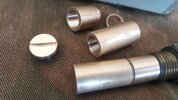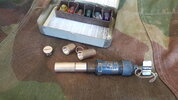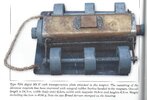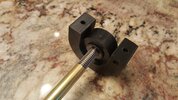British Ordnance Collectors Network
You are using an out of date browser. It may not display this or other websites correctly.
You should upgrade or use an alternative browser.
You should upgrade or use an alternative browser.
British Limpet mine
- Thread starter Fjordhouse
- Start date
very nice find there :cry:
Rigid Limpet Mark I
Nice to see a Mk I (or IA) Rigid Limpet. Development started on them in 1941 as a replacement for the MD1 versions. Early experiments were done at SOE Station IX (Welwyn) and Portsmouth dockyard but the substantial progress was acheived at Station XII (Aston House). There are a number of experimental variations but the first 'production' type had 10 magnets quickly replaced by the six magnet version (the Mark I) when the Alcomax magnet came along. The Mark IA differs from the Mark I simply by the addition of a rubber sealing washer in the filling cap. The 'more common' Mark II has a well underneath to take an anti-removal switch. A Mark III was designed at the end of 1943 which had a large filler cap at each end. Development of the Mark III ceased in 1944 and I don't believe any were issued to the field. Just 33,500 of the British Rigid Limpet were manufactured during the war. I say British because the Americans made a copy for use by OSS, it had a plastic body and frame.
[Ref HS7 Files at PRO]
Hello, i found this items on the Detling show last week, very happy Ben
Nice to see a Mk I (or IA) Rigid Limpet. Development started on them in 1941 as a replacement for the MD1 versions. Early experiments were done at SOE Station IX (Welwyn) and Portsmouth dockyard but the substantial progress was acheived at Station XII (Aston House). There are a number of experimental variations but the first 'production' type had 10 magnets quickly replaced by the six magnet version (the Mark I) when the Alcomax magnet came along. The Mark IA differs from the Mark I simply by the addition of a rubber sealing washer in the filling cap. The 'more common' Mark II has a well underneath to take an anti-removal switch. A Mark III was designed at the end of 1943 which had a large filler cap at each end. Development of the Mark III ceased in 1944 and I don't believe any were issued to the field. Just 33,500 of the British Rigid Limpet were manufactured during the war. I say British because the Americans made a copy for use by OSS, it had a plastic body and frame.
[Ref HS7 Files at PRO]
Nice info Norman, Thanks for it :tinysmile_grin_t:
Norman, you are a star, Ben
Today i finally got a Magnet for my Limpet MkII which was missing one from the day i got this, Thank You Bonnex, 2 additional pictures of the set i have, still need anti removal switch for the well or blanking plug, the protection plate is for a Mk1 i need and plate with hole in for fitting the anti removal switch, im not sure if my life span can for fill the last 2 wants ,,,,,,, Dave






Today i finally got a Magnet for my Limpet MkII which was missing one from the day i got this, Thank You Bonnex, 2 additional pictures of the set i have, still need anti removal switch for the well or blanking plug, the protection plate is for a Mk1 i need and plate with hole in for fitting the anti removal switch, im not sure if my life span can for fill the last 2 wants ,,,,,,, Dave
View attachment 101945 View attachment 101946 View attachment 101947
Dave,
A bit of pedantic stuff:
The wooden block in the AC Delay tin holds a No 28A Burster. This burster was obsolete by the time the Mark II Rigid Limpet came into service. The Mark II Rigid Limpet used an AC Delay with an ES6 Burster in a short wooden block. The AC Delay set with a No28A Burster (dummy) is uncommon.
The device at the bottom of your picture is a Waterproof Initiation Unit with the body of a Mark II AC Delay screwed into it. They are different generations and don't go together. The Mk II AC Delay is wartime and only 5000 were made. The WIU presents its output on a Cordtex tail so could conceivably be used to function a limpet mine but the Rigid Limpet was theoretically out of service by the time the WIU came along.
Some sorting out needed with lot then, I know the delay tin was early as no markings, another limpet required to go with that tin, the WIU come incomplete I did see a complete one with the cordtex tail once but could not remember what was on the end of it, the ignited fitted so went on, thanks for clearing that up, another picture will be taken and added to the post,,,,,,,, Dave
Old thread but have to say I would love to own a limpet like this to go with my A.C. Delay. Even a reproduction would be acceptable for public displays I intend to do. I am aware of the one Relics makes. Anyone else make replicas?
Need a burster too!
John
Need a burster too!
John
I made some progress on this, it will show up on a post of my collection I think I will do today.Old thread but have to say I would love to own a limpet like this to go with my A.C. Delay. Even a reproduction would be acceptable for public displays I intend to do. I am aware of the one Relics makes. Anyone else make replicas?
Need a burster too!
John
I made some progress on this, it will show up on a post of my collection I think I will do today.
Report
Fjordhouse has made some excellent bursters
If he posted pictures on BOCN I will try to find them. I did not have a real one to copy so I used photos and dimensions for a Burster Mk. III that Anders Thygesen put in his excellent book. It looks like a two piece body with a washer, so that's how my friend and I made them. British threads on them of course.


I posted most of my collection on forum yesterday. It includes the Type 6 Rigid Limpet my friend and I made. 3D printed body and magnets, brass outrigger brackets and placing rod piece, steel rods and brass tubes as magnet spacers. I found rubber bushings which fit the magnets perfectly. I think this is the later way they made the magnets flexible but I have not seen a good photo of that. We used brass colored filament for the mine body so when I scratched and scuffed it, "brass" would show.
think he posted the bursters on his face book page, great items you madeIf he posted pictures on BOCN I will try to find them. I did not have a real one to copy so I used photos and dimensions for a Burster Mk. III that Anders Thygesen put in his excellent book. It looks like a two piece body with a washer, so that's how my friend and I made them. British threads on them of course. View attachment 203718View attachment 203719
I posted most of my collection on forum yesterday. It includes the Type 6 Rigid Limpet my friend and I made. 3D printed body and magnets, brass outrigger brackets and placing rod piece, steel rods and brass tubes as magnet spacers. I found rubber bushings which fit the magnets perfectly. I think this is the later way they made the magnets flexible but I have not seen a good photo of that. We used brass colored filament for the mine body so when I scratched and scuffed it, "brass" would show.
CartDorset
Active Member
Pics of the rubber bushes used on the limpet here - a brass (I think) rod through the middle
 www.staybehinds.com
www.staybehinds.com
CART Auxiliary Unit Research
Yes, excellent photos of the funky arrangement. Must have taken some time to assemble. Mine is modeled after what Anders Thygesen called a Mk. II, that had integral rubber bushes glued to the magnets. Below is a photo from his book. I assume it's a service weapon and not a training dummy.Pics of the rubber bushes used on the limpet here - a brass (I think) rod through the middle
CART Auxiliary Unit Research
www.staybehinds.com

After I created dimensions for the printed magnets, which I hope are close, I was lucky to find standard neoprene bushings the exact size of the magnets, which I glued on. This pic shows a steel all-thread rod I used, probably a bolt with hex head would have been more correct, and I cut brass tubes as spacers that bear on brass washers. I don't know if genuine Mk. II mines were assembled this way but it made sense to me. I had my friend program some holes in the magnets for neodymium rod magnets. This is so I can put the mine on the door of my refrigerator at home. My wife loves that!
We used the common PLA filament for the body and magnets and I used ethyl acetate solvent vapor to smooth the layer lines. Parts in a covered casserole dish suspended over paper towels soaked with solvent. But I still had to sand the body. I left the magnets in the vapor quite a long time and they got somewhat rubbery. I could dig my fingernail into them. Looking back, sanding parts that shape would have been better. There is a filament called PVB that can be smoothed with isopropyl alcohol - very common and less toxic than the ethyl acetate. It's not as durable in hot temperatures compared to PLA. It prints about the same.





